[Author’s Note: Two weeks ago, I published a logistical (i.e., gear, sleep, hydration, and nutrition) synopsis of my run at the 2015 Ultra-Trail Gobi Race, as well as what I’d do differently next time. Below, I recount the journey itself. For another perspective that’ll be hard to beat, you can also watch The African Attachment’s 11-minute film on this year’s race.]
First, let me backtrack a moment. I’ll admit that heading into Ultra-Trail Gobi Race (UTGR), I wasn’t a fan of races of 200 miles or more. I mean, how could they be “races” for most people and for those who did “race” them, weren’t such events truly self-destructive endeavors? While other folks could do whatever they wanted, I figured racing — that is, pushing myself hard — such events surely wasn’t for me and, perhaps, I could steer (in some very small way) such events toward becoming explicitly non-competitive adventures in which completion without absolute self-destruction was the goal.
Now, having covered 250 miles in an outing and having seen many more do so from within an event, I’m not so sure that racing 200 miles or more would be such an awful thing, while noting that even fewer people may be aiming to truly race such event than I’d expect. Within humanity’s awesome ability to accomplish mind-blowing feats, there seems to exist a healthy desire for self-preservation and avoidance of self-ruination. In fact, this sense might just be stronger amongst those attempting 200 miles than 100 miles. My personal jury’s still out, but I’m intrigued by the implications.
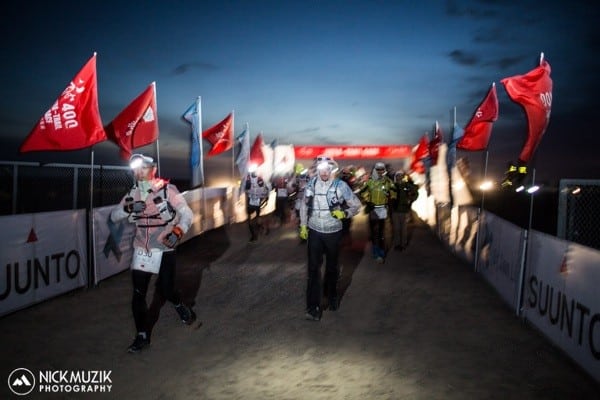
Bryon heads out into the unknown. Photo: Nick Muzik
Day 1 — Better with Betsy (0 to 103.6 kilometers)
Now, back to the event itself. My aim heading into the event and through most of it was to enjoy the experience as much as I could while preserving my body. I would not push hard, ever. When the command to go was given, I immediately found myself at the front with another runner. I gave pause and dropped back. A mile later, I found myself 50 meters behind the two leaders before they took a wrong turn (I yelled to them unsuccessfully), which put me in front. Again, time to relax.
Fortunately, shortly thereafter I made a beeline toward the next checkpoint only to run into an insurmountably high fence. I would need to follow it for a kilometer in the wrong direction over slow terrain before finding a gap. This put me far back in the field and allowed me to relax while going on autopilot in following other runners. More fortuitously, it wasn’t too long until I came upon fellow American Betsy Kalmeyer. We struck up some conversation, fell in sync, and would run together for the next two days.
In addition to the treat of getting to know Betsy, running with her kept my pace calm and helped both the miles and time pass quickly and easily. There were also certainly times like the early miles on Day 2 when Betsy was pulling me along with her relentless forward progress. While I’m certainly an introvert, running with someone — working together with them — has innumerable benefits. With the self-navigational component of this race, a second set of eyes and another opinion also aided with staying on a good line.
Indeed, the self-navigation, open-course style of the race was a highlight of Day 1. During the mid-afternoon heat, Betsy and I had the option of traversing five miles of off-trail rough terrain as suggested by the “recommended track” we were provided as well as the direct waypoint-to-waypoint bearing. However, a pre-race perusal of Google Earth suggested an Etch-a-Sketch zigzagging on established roads for most of the distance to the next checkpoint.
We chose the latter option and, with some en-route referencing of Google Maps thanks to a bit of in-civilization cell service, made it without delay after pleasant passages through a small town and cotton fields amidst their autumnal harvest.

Betsy and Bryon getting it done on Day 1. Photo: Nick Muzik
Late the same day, an off-the-recommended course diversion down a paved highway for five or six miles was not as successful. Night fell as we left the pavement toward the small mountain range we needed to cut through. We headed west along the base of the mountains, but turned back maybe 100 meters shy of the would-have-been-obvious broad wash that would have led us simply and easily to the next aid station.
Instead, we backtracked a kilometer and headed up a tiny wash with plenty of scrambling along with a dose of doubt. Despite this doubt, we pushed on and eventually popped out into what was unquestionably the wash we’d originally targeted and what very soon became part of the recommended route.
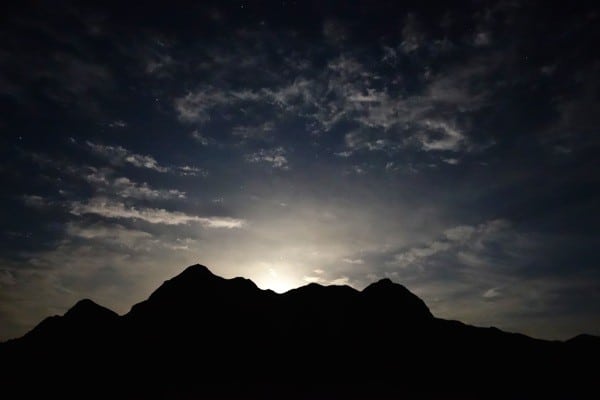
Moonrise on Night 1. Photo: Bryon Powell
Day 2 — A Down Day (103.6 to 176.9 kilometers)
All endeavors have high and low points. In a long ultramarathon, those highs and lows can be obscured by momentary needs as well as the enormity of the undertaking. It’s probably a combination of these as well as a lack of active reflection that kept me from seeing Day 2 as the low point of my race until two months after the fact. I started the day off with tight hip flexors and no pep in my step. With a dead flat, straight-compass-bearing warmup, I trailed along behind Betsy for a long while, eventually pulling out my headphones for a bit of distraction in the form of the Hardcore History podcast.
We had a lovely run up a tree-lined river, but didn’t find an established route up to the day’s first rest point.* We briefly separated and I ended up bushwhacking across a couple of cornfields to the rest point. That was actually amusing. Learning, partially incorrectly, that two of the race’s other English speakers ahead of us had dropped out was a letdown. Many hours later, we’d actually encounter one of the (unofficially) reported dropouts struggling with a knee injury just outside another aid station. She was trying to decide whether to go or turn back, but it was clear she should not try to finish.
* The race had 23 “checkpoints” supplying only ambient-temperature water as well as 10 “rest points” that supplied ambient-temperature water as well as hot water, our drop bag designated for that rest point, and heated communal tents.
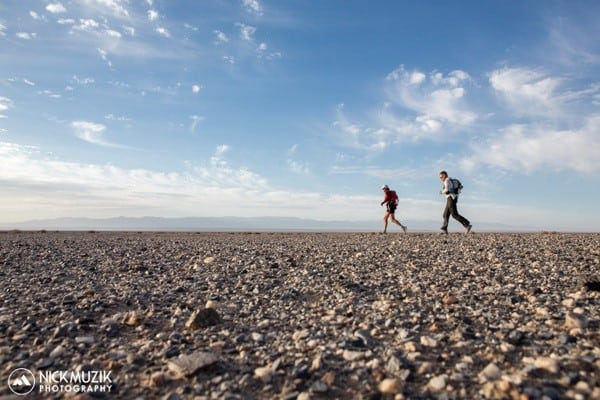
Betsy and Bryon run across typical Gobi terrain early on Day 2. Photo: Nick Muzik
An hour or two later, long after my body had started working well again, Betsy and I unintentionally separated coming out of a small drainage. She went on, while I spent 20 minutes calling and looking for her before deciding it was best for me to go to the next aid station to see if she’d arrived there or to dispatch a larger party to search for her. (She’d arrived and continued on.)
This incident a day and a half into UTGR triggered plenty of emotions: fear as well as frustration that Betsy and I hadn’t talked through what we’d do if we became separated. I’d let them go before reaching camp that night, but they were a burden I carried for some hours. They certainly all flowed forth when I came to the first of a handful of river crossings on the final segment to the next rest point. I was alone at night crossing an occluded river from which came an intermittent slapping sound.
I didn’t know what could make that noise in a remote Gobi river, and it scared me. In my fear, I threw caution to the wind and charged across. As I neared the far bank, I struck the top corner of a perpendicular stone face quite hard with my right shin. My upper body lurched forward and while I caught myself before falling fully, the sleeves and torso of my windbreaker jacket were now soaked on a cool and very windy evening, adding a bit of panic once I emerged from the river.
Although there was a small cut and significant bruising on my shin, it’s fortunate that the injury didn’t noticeably affect my stride later in the race. (Its aftereffects, however, kept me from running for six weeks starting about two weeks after the race.)
Day 3 — Finding Tao… and Fear (176.9 to 299.1 kilometers)
We awoke on Day 3 to howling winds, bitter temperatures, and blowing snow. The three runners in the tent — Betsy, Benoit Laval, and myself — discussed whether it would be prudent to head out in those conditions and, if so, via what route. An hour after waking, I decided I would head out and take a longer overland route rather than the suggested route that continued up the river canyon with more water crossings to come.
As I prepared to leave, Dale Garland, the Hardrock 100 race director and honorary RD of UTGR, walked into the tent and let us know that they’d placed a weather hold on the race until they could find out more about the conditions. As the runner most eager to press on, I chatted with Dale (mostly expressing that the next rest point was just below the race’s high point and that it would be best for us to have time to clear that point before dark as it wasn’t ideal to sleep that high) and felt like the race was in good hands.
Although I’d already eaten my breakfast, I settled back into my sleeping bag and continued to eat — something I did anytime I wasn’t moving or sleeping during the event. An hour later we were once again loosed upon the course.
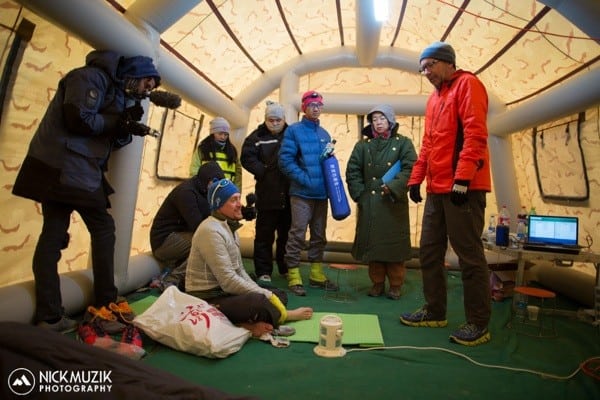
Dale and Bryon chatting on Day 3. Photo: Nick Muzik
Benoit and I headed out together. A night’s sleep and, perhaps, the paused start to the day reset my perspective. I would coolly and calmly approach the day and the event. I was at peace heading out on a “long cut” through the snow with a relative stranger. We had a mutual challenge and we would embrace it together.
We made a long U-shaped route perpendicular to the recommended route. We knew we could follow a basin out to a road, climb over a small mountain range, and then take the road back to the next aid station. When on the return leg, we discovered we could have taken a shorter route we’d considered where power lines traversed the range, we didn’t give pause or regret our decision. The same goes for when we arrived at the next aid station after Betsy, who’d left the rest point shortly after us, but had taken the recommended river-canyon route.

Benoit Laval and Bryon Powell run out into the snow on Day 3. Photo: Nick Muzik
From that aid station, we had roughly a marathon to run on paved roads as the course gradually climbed to its high point. Benoit and Betsy quickly pulled away while I settled into a self-preservational effort. I ran easy when the grade was gentle and walked (briskly) when I wished to do so. Relentlessly, on and on, beckoned forward by the charm of the highway strip. Onwards and upwards, as they say.
It was during this stretch that I thought of my favorite Catholic/Taoist mashup: The Way of Chuang Tsu by Thomas Merton. Many years ago, my uncle gifted me this book and it’s been my favorite ever since. I’m no Taoist, but some of the stories in the book resonate deeply. In my favorite piece, “Cutting Up an Ox,” a wizened butcher cleaves an ox seemingly without effort or strain. He once hacked at his work, using his strength and dulling his blade while chopping the animal to pieces. It was only after much time that he came to see the animal as a whole and begin to easily free its constituent pieces. It is the latter to which I aspired throughout this day. No pushing it, no struggling, no surging … just engaging myself and my senses and waiting for the course to fall, one checkpoint at a time.
And, so it went, on down the road. The morning’s clouds cleared and the temps moderated. The only interruptions were stops to fill my water bottle, shed layers, and, finally, apply a bit of sunscreen to my right side, as the clouds cleared, temps rose, and the high-elevation sun slowly baked me.
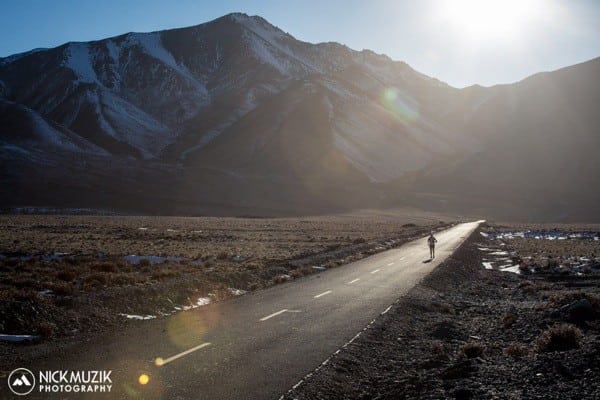
Bryon on the long road to the high point. Photo: Nick Muzik
Soon after passing Rest Point 6 (221.5km), we crested the high point and started cruising down. One turn off the road and we’d be on dirt until the race’s final few miles. To say that I was on autopilot would be misleading, but, now, a full two-and-a-half days into the venture, motion just happened. It was merely my job to discover the footplants, the running lines, and, quite significantly, the astonishing beauty around me.
Well, around us, as Benoit and I were running together again as the sun kissed the horizon. We were descending wide-open grasslands with grass tufts scattered across unending alluvial deposits. The tufts glowed golden in contrast to the periwinkle sky and royal purple mountains crowned with still shimmering glaciers. It was one of those sublime stretches that will stick with me for many days to come.
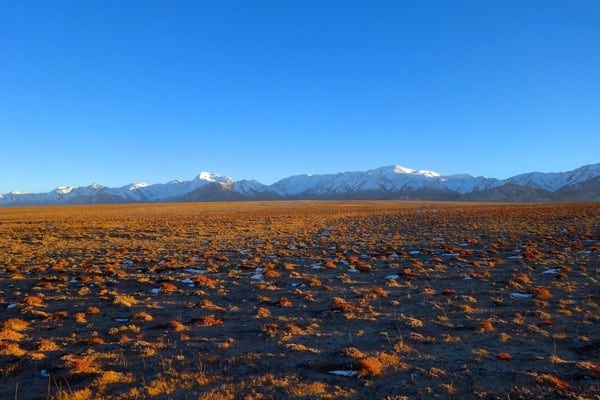
A splendid sunset on Day 3. Photo: Bryon Powell
The golden hour was unrushed, seemingly lingering 90 minutes or more as we and, then, I descended the everlasting grade. Thankfully, for much of this stretch, I was able to follow the winding path of primitive doubletrack rather than meticulously finding lines across braided, barren stretches through which water must gush from time to time.
An hour or two later, after moonrise but well before midnight, I hit Rest Point 7 (269.8km). The two previous days, I’d called it a day after reaching a rest point at night. Overall, I had no firm plan, but had stuck to my goal to get full nights of rest early on. This time, my legs felt great, my energy and mood were solid, and, most important, I wasn’t the slightest bit sleepy. On I would go!
Leaving the rest point, the moon hung bright and high enough that I left my headlamp off. I’ve long loved being able to travel outdoors by moon or starlight and the multi-hour hike up washes to the course’s second-highest point provided just such an opportunity.
That said, I would battle two fears this night. Shortly after Rest Point 6, I’d encountered the first packs of large, unleashed dogs. This was sheeping country and each flock was guarded by a pack, usually with indirect human supervision. (There were often signs of people, such as a small house or hut.) During the day, I mustered some confidence to pass through or go around a few packs, but each time they would bark ferociously while tracking my movements. Would my courage crumble if I faced the dogs at night?
My second fear was of night itself or, I suppose, what could be out there in the darkness. There are places I feel more comfortable alone at night in the wilderness, such as Europe or New Zealand, and places where I feel less comfortable, such as the mountains of the Rocky Mountain West. I was unsure how I would feel in the complete unknown that was the Gobi and its mountains.
In finding fear, I also found the means to get past it. Three days in, the simple rhythm of motion was engrained and the joy and wonder of traveling by moonlight drew me onward. Up and up and up via wash, then wasteland, then canyon-bottom creek bed before scrambling up the final few 100 meters over a mountain range’s crest.
At the summit, I could see a town for the first time since the early morning. Far off, many dozens of miles away, lights flickered. I imagined it was the finish that I might reach in a day and change. Somehow, in the context of the UTGR’s enormous scale, that instilled a bit of confidence. I could see the finish. Literally.
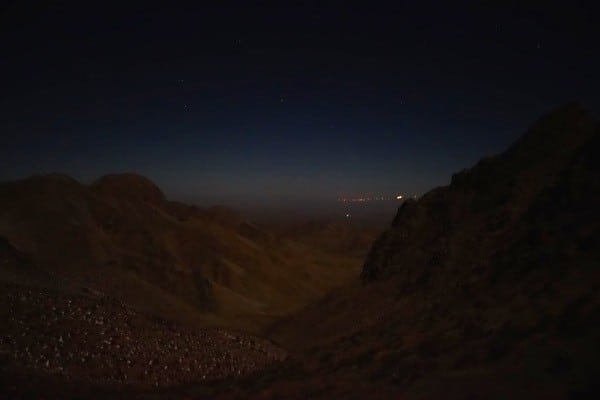
Seeing the finish. Photo: Bryon Powell
Down the other side, first on steep, treacherous, snow-covered game trails, then over choose-your-adventure berms, before entering a wash that would clearly lead, eventually, to the desert below. Bark. Barkbarkbark. Glowing eyes in the distance. Crap. I was no longer in vast grasslands with sheep dogs, I was in a narrow canyon. Only one way down. “Ni hao.” “NI HAO!”
There was a small prefab building in the distance and, despite it being two in the morning, I wanted to get someone’s attention before shit went down. The whole time, I kept moving. BARKBARKBARK. Barkbarkbark. Bark. Silence. In the matter of three minutes, my heart rate went from normal to racing to normal again. The dogs were with their sheep. So long as I passed without approaching the sheep, all was well. I continued down the draw until it opened up to another seemingly unending expanse of desert.
I was in and out of a checkpoint and into, well, a sea of gargantuan earthen tentacles where ancient floods had scoured a vast alluvial fan. I saw the light of the next checkpoint, but it might as well have suggested that I walk on water with the number of uncrossable creases between it and my present position. I tried to follow a straight path, but quickly yielded. I ducked down into a wash and followed it. It narrowed into a slot canyon straight out of Moab, Utah, my hometown.
Fortunately, this triggered my desert-navigation instincts and with no cliff bands in sight, I trusted them to take me down toward the valley bottom at which point I could navigate to Rest Point 8. It all worked out, but these sections took longer than expected. I pulled into the rest point just before sunrise. I ate a meal, as I had after arriving at every rest point through the race, and prepared for sleep.
Day 4 — Joyous Acceptance (299.1 to 402.2 kilometers)
After setting my alarm for six or seven hours later, I fell asleep, but soon thereafter the sun hit the large tent, which turned into a solar oven. I woke up a sweaty mess. Time for breakfast… and to keep going. This wasn’t the plan, but I felt good, so why not? Well, maybe the second section of the day had I know what was coming! The first section was a pleasant run down a wash that was generally very easy with a bit of handwork down some drops to make things fun. Then… then, what I hoped at the time was the hardest section of the course.
In theory, it was easy — a relatively flat section with great footing, but there was one slight problem, we were running perpendicular to ridges for 10 kilometers. I felt I would finish the race, but this stretch was still demoralizing. My feet were already badly blistered and the building heat, intense sun, and lack of accessible water made this stretch seem interminable. In retrospect, listening to late-1942, early-1943 Ostfront history probably did little to boost my mood.
Finally, I crossed a dry river, headed up a kilometer of easy terrain, and cut through a small ridge to see a canyon ensconcing the next checkpoint. Dropping sharply down, I was relieved. I now knew better than to presume what was ahead, but I knew I was 320 kilometers into the event… that meant only 50 miles to go.
I only had one section to the next rest point… and, then, only one rest point to go. Ahhhhh. I can do this. I will do this. [Amazingly, this was also the first time during the entire race that I learned my position (third). It was my goal not to “race,” so this prolonged ignorance was a wonderful gift.]
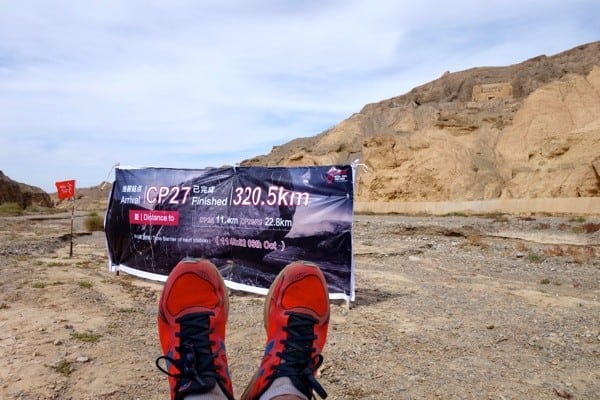
“Only” 80k to go. Photo: Bryon Powell
Fortunately, this next section was easy: a mile or so down a road through a wash watched by dozens of Buddhist caves before a long stretch across easy desert terrain. The day was moving along with the sun and heat at my back and yielding. Another deep exhale.
I didn’t think twice about continuing on from this, Rest Point 9 (343.3km), although sunset was quickly approaching. If I’d known what was coming, I may have thought twice. The race’s stage sheet described the next section as 2.5km “Gobi,” 5.5km “Yardang” (the Gobi’s distinctive wind-sculpted earth creations vaguely reminiscent of snow-blown sastrugi), 2.5km “Desert,” and 6.2km “Barren Terrain.”
The first two sections were as expected, and completely gorgeous on what I hoped with my last sunset and dusk of the race. I blissfully absorbed it. Then, all of a sudden, I was in sand dunes. Huh? I’d seen enormous dune fields flying over the Gobi a week earlier, but these were the first I’d encountered on foot. They were slow and frustrating. I’d not brought gaiters for this stretch, so I stopped a few times to dump sand from my shoes as it would only exacerbate my blisters.
As the dunes rose from a few feet to many meters tall, I began to get disoriented. I wasn’t moving fast enough to rely on my phone’s GPS app, which relied on my motion to give a bearing. Out came the compass and an improvised, in-the-field navigation lesson. Within a few minutes, I was reassuringly on my way in the right direction, confirmed by a dune-top sighting of the next checkpoint’s light. However, the damage was done … my feet were officially a hot mess. They’d been badly blistered for quite a while, but all the off-camber, shifting footing on the dunes along with the abrasive sand in my shoes brought the pain to a crescendo … or so I thought.

The sunset on Day 4. Photo: Bryon Powell
After the mile and a half of full-blown dunes, I crossed a mix of slow-going, densely vegetated “barren terrain” and low dunes for another 6.2 kilometers. On arriving at the checkpoint, I could see the light of the next rest point, the final one. Only a straight 10 kilometers over flat ground and I’d be in the home stretch. I got this, I thought. I should know better!
The next 10 kilometers were the most trying of my running life. The footing was absolutely impossible. Imagine soft alkali soil. Now, throw in large tufts of grass randomly spaced about half a meter apart. Now, have the tufts relentlessly shorn by sheep to an inch of grass on a 6-to-12-inch pedestal. Between the tufts, there are just a few inches of soft, uneven ground that’s only occasionally wide enough for a narrow shoe to plant. There’s no reliable road or trail and the rare faint game trail offers no more than a few seconds of easy travel. The only solution? Running on top of the shorn tufts.
Fortunately, my legs and energy were sufficiently well preserved that I could run from tuft top to tuft top, at least in theory. However, theory only goes so far, as would be the case for my spurts of running. You see, every 10, 20, or, if I was lucky, 100 steps, the pedestal on which I landed would give way. Sometimes, the entire alkali mound would condense. More often, that top inch of grass stubble would collapse in one direction or another. Regardless of the cause, every time a pedestal collapsed, the planted foot would shear and the raised foot would catch me, but with an uneven plant on an uneven surface. Ouch. To the max. Many, many times.
But it was okay. I accepted it. With joy (when I could). At times, I found myself with pursed lips and tensed muscles. I was fighting through the pain. But for how long could I do that? And why would I? I would catch myself in such a state and change course. I’d accept the pain. It was there. It was inevitable. However, it wasn’t permanent. It was only pain. I would relax my upper body. I would breathe deeply and slowly. Sometimes, I was thinking about yogic breathing, even if I couldn’t achieve that.
Regardless, the purpose and peace that came with thoughtful breathing was therapeutic. I knew that, eventually, I would reach the end of this “camel crud,” as Betsy and I had named a lesser version of this terrain three days earlier. When it did, I’d be that much closer to the finish.
That’s not to say I didn’t feel the pain or take the occasional standing 10 count when my inertia was sapped and pain amplified with the whatever-th misstep in a short span. I did. I also spent plenty of time — maybe more than I should have — searching on Google Maps for more well-trod route. (There was cell service for first time in quite a while.) The pickings were slim, but I did take a route 30° off direct to enjoy the minimal pain of running down a dirt road for a mile.
The footing mercifully evened out as I approached the final rest point (370.2km). It was the middle of the night, but, aside from my feet, I felt great. I was motivated to finish and never questioned whether I would go on. For the first time all race, I skipped eating the backpacking meal in my drop bag. I downed a Coke, maybe ate a few wafer cookies, and set out for the finish.
Leaving the final rest point felt … awesome. I only had 32 kilometers to go. The first 13 would be up and over a small mountain range, which based on previous experience, suggested benign footing. After that, it was likely road or level “Stony Gobi” (also easy running) to the finish. I gave Meghan Hicks a quick call back at home as I left the aid station. It was the first time I’d chatted with her in four days and it gave me a great lift. As did hearing from her — as she’d been watching the race tracker — that it was hours to the next runner in front of and behind me. I would get to enjoy these final hours by myself without any temptation of racing.
Many times from here to the finish I would marvel at the human body and its capabilities. I’d covered over 200 miles in four days and could still run. As the route gently climbed, I’d jog the shallow ups and coast the flats. Once over the top, it was easy progress on the downs, although I’d mix in a few seconds of walking every few minutes. At this point, it felt nice to mix it up.
As I cleared a mountain canyon’s mouth, I could see the city in the distance. The finish was once again in sight and, this time, in a much more tangible way. I would be there in just a few hours whether I ran every step or walked the whole way. Dawn broke as I exited the penultimate aid station. I was awash in bliss. As I shed the night’s layers, I felt free. I would savor every remaining step.
The euphoria built with every kilometer that passed after the final checkpoint. I ran every step I could. I texted my sister a selfie with “Inchey,” a little inchworm Beanie Baby that I carry to remind myself of my two nieces — Maya and Norah — and by which I share my worldwide adventures with them. Tears welled up. I hoped I could inspire them, even if just a little.
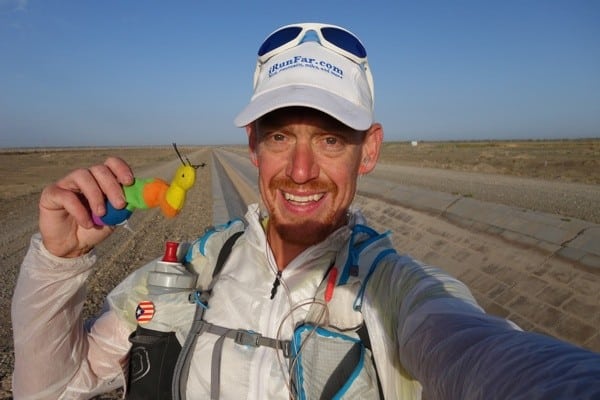
Sending a “Where’s Inchey” photo (and maybe some inspiration) to my nieces. Photo: Bryon Powell
I tried to inspire myself as I came off a long canal-side dirt road onto pavement that I knew I’d be on until the finish. I ran and ran and ran. Not fast, but it felt so good to be able to run. Actually, it was mind-blowing, and one of my favorite, if rare, feelings from long ultramarathons. On the outskirts of town, I stopped once or twice among the cotton fields to preventively stretch my calves. They’re my Achilles heel and were a bit tight after 400 kilometers.
A left-hand turn took me out of the cotton fields and a quick right-hand turn put me onto a minor highway. At that intersection, two race officials joined me. I’d hoped to savor the final few kilometers by myself as my reward for the prior 400km. Alas, I would have company… but I would make them work! ;-) Again, it wasn’t “fast,” but that final flat mile to the finish was my fastest of the entire race.
I’ll long remember making the final turn into the park and speeding along the marble tiles and up the steps. My new Chinese friends were there as was my old friend Dale. Now, I was happy to be with others, to share the moment, to savor it. I was done. I had done it. Wow.
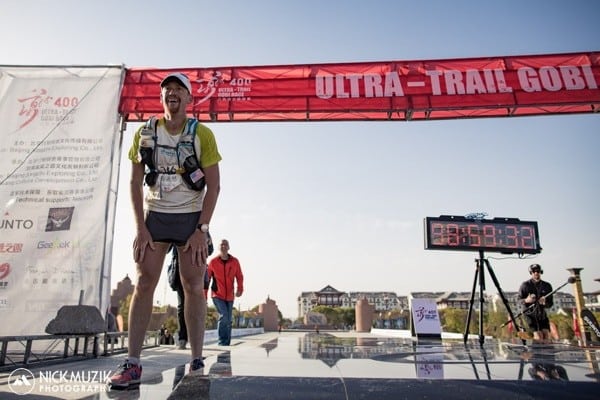
Done! Photo: Nick Muzik
After Thoughts
The UTGR capped a year of pushing my boundaries and clearly establishing foundational efforts in new realms. While I’m no mountain adventurer, I proved to myself that I had the chops to get around the Hardrock course little worse for wear. Over a few months this spring, I showed myself that I could train at a much higher volume, both in terms of miles and hours, than I’d ever thought possible.
In September, a friend coaxed me to the summit of a Norwegian peak with scrambling well outside my admittedly confined comfort zone. With UTGR, I found that not only do I have an “all-day pace” that I discovered more than a decade ago when I first came into ultrarunning, but I also have a theoretical “all-week pace.” Give me food and water, and, well, I now think I can keep going for more than a few days straight.
Both of the event-based efforts — Hardrock and UTGR — were designed and implemented with a “just-finish” approach. They are the foundation. When I toe the line at Hardrock next July, it’ll be with the express aim of coming closer to my potential. Similarly, if I ever make it back to the Ultra-Trail Gobi Race, I’ll pull off the training wheels and have a deeper look into what I’m capable of.
This year, UTGR took me four days and three hours. I don’t think I can go under three days, but I think I can be closer to three days than to four. This year, I repeatedly took theory into the crucible of experience. In the future, I will take that refined knowledge and see what I can make of it.
This was also a year I went into desperately looking to find something I’d strayed from in my running: drive. In taking on bold, new challenges, I was able to reengage that drive. While I have little idea of what my racing and adventuring schedule will look like for 2016, you’d best believe that drive, that passion in effort and exploration will once again be a key focus. There will be no going through the motions. I could not be more thankful for or happy with my 2015 running season for demonstrating so clearly the importance of this to me and my running. Onwards and upwards.
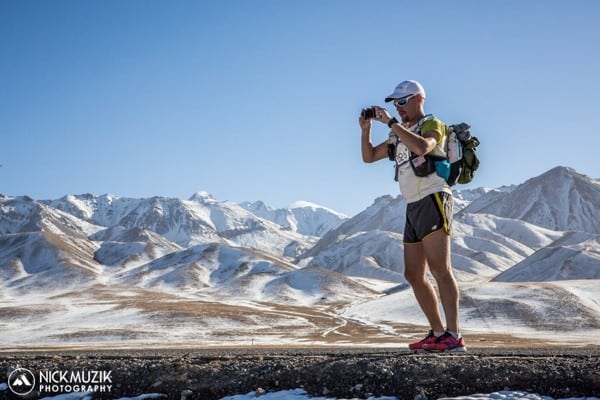
More running and fewer photos next time! Photo: Nick Muzik
A Bit More
- My Strava track
- Facebook photo galleries: pre-race, Days 1 and 2, Days 3 through 5
Call for Comments
- If you’ve run a 200-mile or longer race or outing, what was your experience like? What were the highlights? What were the biggest challenges?
- Have any questions about my journey? Ask away!
Addendum: UTGR Back at Home
It’s more than two months after the Ultra-Trail Gobi Race and, still, it often hangs meaningful in front of me, quite literally. My computer desktop, in front of which I spend too much time, still features the image below that I snapped on the third evening of the race.
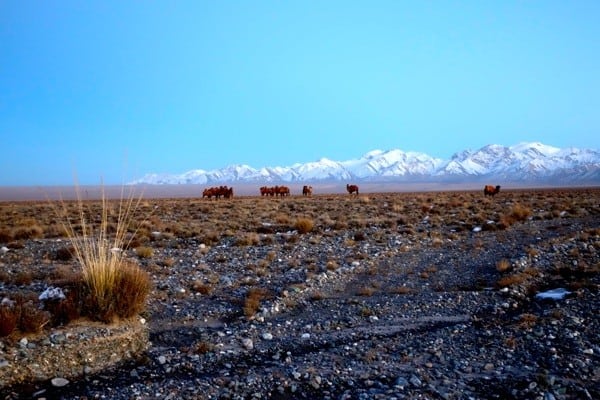
Camels grazing at dusk on Day 3. Photo: Bryon Powell
Below my monitor sits the “tiger tally.” In ancient China, local commanders would hold the left half of a bronze tiger, while the emperor held the right half. If the emperor wished to dispatch the local troops, his emissary would present the matching half of the tiger to the local official. Two evenings before the race, every participant received one half of a tiger tally … and would only receive the matching piece upon finishing.
I actually left my half in my final drop bag and carried it the final 30 km so I could present it at the finish. Reuniting the tiger would be my goal for this event. Now, before leaving my office in the evening, I separate its two pieces and place one on each side of my monitor’s base. The next morning, I create a discrete list of items to accomplish that day.
Until those tasks are complete, the two halves of the tiger tally sit separately within my peripheral vision. They are a constant reminder that I am not finished. I must focus on the task at hand. I must go on.
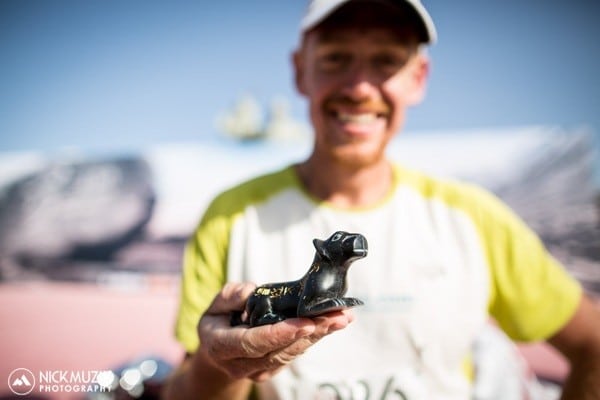
A smile after reuniting the tiger tally. Photo: Nick Muzik
Off to the side of my desk sits a most unexpected gift: a hand-carved stone dragon-shaped cup. I may not use it often, but it’s easily one of the coolest items I’ve ever received at a race. I mean, it’s a stone dragon drinking cup. How badass is that?
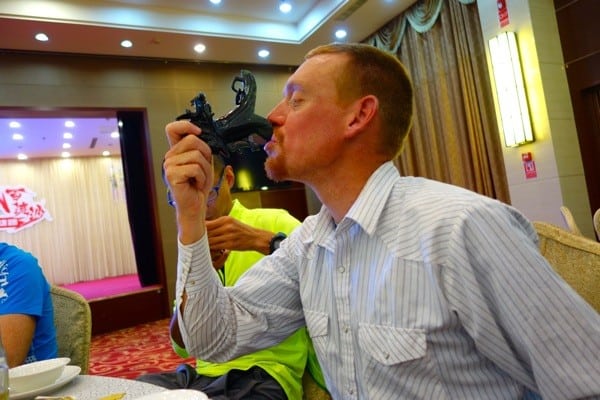
A little celebratory swill. Photo: Unknown tablemate.
My reminders of the Ultra-Trail Gobi Race don’t end when I leave my office or close my laptop. No, I think of the race often. Perhaps most often as I lie in bed drifting off to sleep. I remember the spectacular images I captured in my mind during the race. I visualize the course, noting key turns, stretches that were a mental challenge, and rerouting sections that I’d tackle differently next time. I dare to dream … just a little of what I might be capable of and how to make that happen.

What’s next? Photo: Bryon Powell
